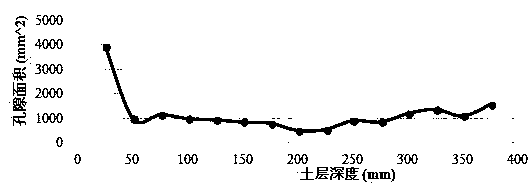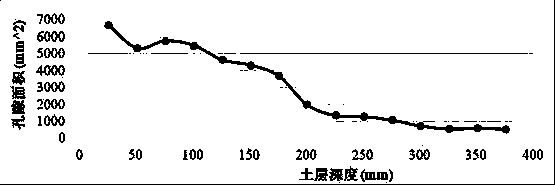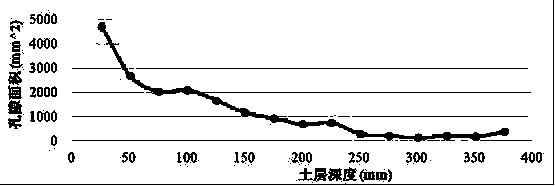Method for determining and analyzing pore structure of saline-alkali soil
A technology of pore structure and measurement method, applied in the analysis of suspensions and porous materials, analysis of materials, permeability/surface area analysis, etc., can solve problems such as soil measurement that cannot have large pore properties
- Summary
- Abstract
- Description
- Claims
- Application Information
AI Technical Summary
Problems solved by technology
Method used
Image
Examples
Embodiment 1
[0060] A method for measuring and analyzing the pore structure of saline-alkali soil. The soil sampling container is a PVC hard pipe with an inner diameter of 11 cm, a length of 40 cm, and a pipe wall thickness of 0.5 cm. One end is ground into a knife-edge. The test site is located in Dafeng Nature Reserve (32°59’N, 120°49’E) in Yancheng, Jiangsu Province. The soil tested was natural saline-alkali soil for Jerusalem artichoke planting - no human disturbance (no fertilization, no irrigation) except grass mowing before Jerusalem artichoke seeding. The soil was plowed using conventional mold boards. Jerusalem artichoke has been grown on natural saline-alkali land for 8 years (row spacing 60cm, plant spacing 40cm). Plant at the end of March every year and harvest at the end of November. Jerusalem artichoke planting areas were classified as high-salt (>4.0 g salt kg- 1 Soil), medium salt (2.0-4.0g salt kg- 1 Soil) and low salt (1.0-2.0g salt kg- 1 earth).
[0061] Select a h...
Embodiment 2
[0064] A method for measuring and analyzing the pore structure of saline-alkali soil. The soil sampling container is a PVC hard pipe with an inner diameter of 11 cm, a length of 40 cm, and a pipe wall thickness of 0.5 cm. One end is ground into a knife-edge. The test site is located in Dafeng Nature Reserve (32°59’N, 120°49’E) in Yancheng, Jiangsu Province. The soil tested was natural saline-alkali soil for Jerusalem artichoke planting - no human disturbance (no fertilization, no irrigation) except grass mowing before Jerusalem artichoke seeding. The soil was plowed using conventional mold boards. Jerusalem artichoke has been grown on natural saline-alkali land for 8 years (row spacing 60cm, plant spacing 40cm). Plant at the end of March every year and harvest at the end of November. Jerusalem artichoke planting areas were classified as high-salt (>4.0 g salt kg -1 Soil), medium salt (2.0-4.0g salt kg -1 Soil) and low salt (1.0-2.0g salt kg -1 earth).
[0065] Select a m...
Embodiment 3
[0068] A method for measuring and analyzing the pore structure of saline-alkali soil. The soil sampling container is a PVC hard pipe with an inner diameter of 11 cm, a length of 40 cm, and a pipe wall thickness of 0.5 cm. One end is ground into a knife-edge. The test site is located in Dafeng Nature Reserve (32°59’N, 120°49’E) in Yancheng, Jiangsu Province. The soil tested was natural saline-alkali soil for Jerusalem artichoke planting - no human disturbance (no fertilization, no irrigation) except grass mowing before Jerusalem artichoke seeding. The soil was plowed using conventional mold boards. Jerusalem artichoke has been grown on natural saline-alkali land for 8 years (row spacing 60cm, plant spacing 40cm). Plant at the end of March every year and harvest at the end of November. Jerusalem artichoke planting areas were classified as high-salt (>4.0 g salt kg -1 Soil), medium salt (2.0-4.0g salt kg -1 Soil) and low salt (1.0-2.0g salt kg -1 earth).
[0069] Select a l...
PUM
| Property | Measurement | Unit |
|---|---|---|
| diameter | aaaaa | aaaaa |
| density | aaaaa | aaaaa |
Abstract
Description
Claims
Application Information
 Login to View More
Login to View More - R&D
- Intellectual Property
- Life Sciences
- Materials
- Tech Scout
- Unparalleled Data Quality
- Higher Quality Content
- 60% Fewer Hallucinations
Browse by: Latest US Patents, China's latest patents, Technical Efficacy Thesaurus, Application Domain, Technology Topic, Popular Technical Reports.
© 2025 PatSnap. All rights reserved.Legal|Privacy policy|Modern Slavery Act Transparency Statement|Sitemap|About US| Contact US: help@patsnap.com



